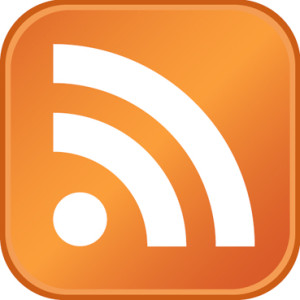The buzziest of buzzwords lately has been RSS. With Google Reader closing its doors (which we’re still not over – we miss you Reader! Nothing is quite as good as you *sob*), everyone has been desperately hunting for a replacement to read their favourite blogs (with the latest casualty from this migration being the Old Reader)
But what exactly is RSS? Why do you need to know about it as a blogger?
RSS is most commonly defined as Really Simple Syndication, and is a web standard format of subscribing or syndicating a website’s feed. RSS isn’t just for blogs, it can be used for Twitter feeds, YouTube updates, comments on blogs – basically anything that will be updated! The logo to the right is the most accepted logo to represent RSS feeds – look out for this if you want to find the feed of a site!
RSS can be read by many websites and programs – we discussed in this blog post which web based readers are available, but most browsers and mail programs have this ability built in.
RSS is useful because it pulls in all the information you need into one place. If you have 10 blogs that you love to read, instead of visiting those blogs every day to see if they’ve posted anything new, an RSS reader will pull in any new posts for you to save you time. You will only ever see the latest posts from a blog, which will save you time in loading them (especially useful if you read blogs on your phone!) and you’ll never miss anything because you didn’t check for a few days.
Some browsers will “find” the RSS feed for the site you’re on and highlight the RSS feed in the toolbar to make it nice and easy to subscribe, and most blogs will have it as a button somewhere. However, if you can’t find the feed on the site, here’s a few shortcuts which might help you!
For Blogger blogs, here’s the feed link:
http://blogname.blogspot.com/feeds/posts/default?alt=rss
Replace blogname with the URL of the Blogspot blog you want. There are quite a few other feeds that you may find useful for Blogspot blogs – you can find out more about them from this Google help post
For WordPress (both .com and self hosted), the feed will most of the time be the site URL with /feed at the end. So, for example, the feed to this blog would be http://www.bonjourblogger.com/feed
http://blogname.wordpress.com/feed http://www.blogname.com/feed
Again, replace blogname with the blog you want to subscribe to. There are more feeds available for WordPress blogs – for example, you could subscribe to all posts categorised in a certain way – which you can find more about on this WordPress help post.
We think that’s about it for RSS – let us know if there’s anything else we haven’t covered here!







I was a big fan of Google Reader, but now like Bloglovin!
Can you do a post on how feedburner/mailchimp works for email subscribers? I have feedburner on my wordpress blog but appar it’s not working/phasing out so have been advised to install mailchimp… No idea where to start!!
I like Bloglovin for actual blogs, but I don’t feel like it works so well for sites like The Verge where I want to just read a summary of the post before deciding to read it all.
I shall add this to the list – I’ve not looked at email subscriptions before, but it seems like something that might be quite useful!